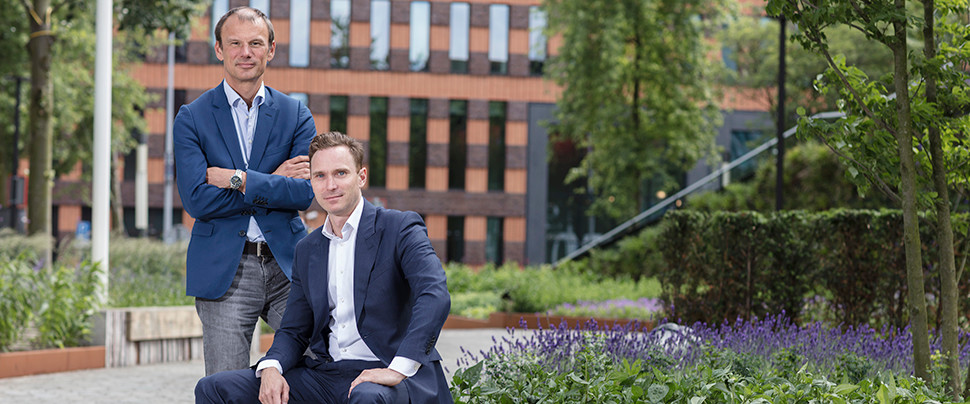Commercial property on its way to energy label A


Our commercial property business unit has set the bar quite high with its sustainable ambitions: by the end of 2018, the bank wants 30% of all its financed real estate to have an average energy label A, from just 1% in 2015. Although the transition is taking place at a rapid pace, the ambition does not seem entirely realistic. But Erik Steinmaier and Olaf Rutten emphasise the great strides that have been made so far, together with clients. Underlining this progress, ABN AMRO has been crowned the most sustainable real estate bank of 2017.
Transition leader commercial property Olaf Rutten explains why setting such a high ambition was a deliberate choice. “If you really want to get things rolling, it's better to aim high. If we had set ourselves the goal of 5 or 10%, then yes, we would have accomplished the goal, but we also would not have made it as far as we have now. In three years, we've improved our score from 1% to nearly 15%, and the year isn't over yet.” Just as we see in other business units, the commercial property carbon reduction plans are part of Mission 2030. By that year, all of the real estate financed by ABN AMRO is supposed to have an average energy label A.
Energy label C by 2023
Meanwhile, the government has introduced new regulations for the future, too. By the year 2023, all Dutch offices are required to have an energy label C or better. If a building doesn't meet that requirement after the deadline has passed, it is no longer eligible for refinancing. Olaf notes that this prospect prompts action from many office owners. “The government's regulation is especially useful in getting the stragglers to start making changes. We’re raising this topic with our own clients as well. As financiers, we will not want to keep any office buildings with an energy labels lower than C in our portfolio.”
The bank is currently identifying those office buildings that still lack an energy label C or better. Olaf: “We approach these clients with the request to make a plan to realise the transition. From our central system we monitor progress, and when needed, we help our clients meet the new requirements before time runs out. No matter what, we don't finance or refinance before a plan has been drawn up. Fortunately, most clients are upgrading the sustainability of their buildings straight to energy label A.”
ABN AMRO Sustainable investment tool
“We've created a Sustainable investment tool for clients,” Olaf continues. “Any office owner who wants to get started on their energy transition would benefit from using it. The tool first establishes the current status of the building and then outlines what needs to be done to make it energy-neutral. Furthermore, it calculates what measures need to be taken to achieve a certain energy label, and tells you the effects of doing so. Since we want our clients to actually go through with those recommendations, ABN AMRO is offering 100% financing for these improvements. The CFP Green Buildings tool is free to use, which keeps it accessible. You'd probably be spending over 2,000 euros if you hired a consultant for this.”
Solar and wind energy
Olaf also discusses the question of what's holding back the broader transition. “All in all, the housing market is lagging behind. Looking into it, that makes sense. If you own an apartment building with 80 residences, you have to individually make all of those homes more sustainable. Since that takes a lot of time and money, cost-effectiveness is a factor.” Olaf says the bank is exploring other options too. “If a building has a poor energy efficiency score because it's a monumental building with a constant draft, it doesn't mean you should just do nothing. You could switch to a renewable source of energy such as solar or wind energy.”
The right to copy
Commercial property director Erik Steinmaier emphasises the importance of working together. “We could come up with an endless list of suggestions but it's still up to the client to realise these changes. As such, we’re open to hearing their plans. We spend a lot of time exchanging experiences and we also put clients in touch with one another.” The right to copy is gradually becoming the starting point. Erik says these are inspiring times. “Recently, we were introduced to ASR's best practices. This residential real estate investor has facilitated a for some of its residential properties. We were given the opportunity to have a look behind the scenes, and the quick wins and plan of approach have benefited us a lot.” In turn, ABN AMRO allows others to copy from the bank too. Erik: “We regularly bring our clients together during events, such as the recent 'Groene versus bruine kantoren' event.”
Towards an energy-neutral 2030
When asked about any highlights among projects, Erik has his answer ready: the Bajes Kwartier in Amsterdam. is to become a testing ground for sustainable energy generation, circular use of materials and healthy urban living. ABN AMRO plays the role of financier, partly selected because of its Mission 2030 sustainability ambition. Erik observes: “Energy transition and the circular economy come together in this project, with everything revolving around the user. The vision is to create a new hotspot where people can live, work and relax while pursuing an inspired, green, healthy and happy lifestyle. We're aiming for zero climate impact.”